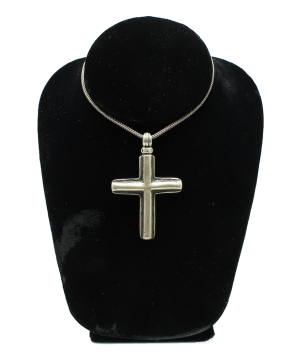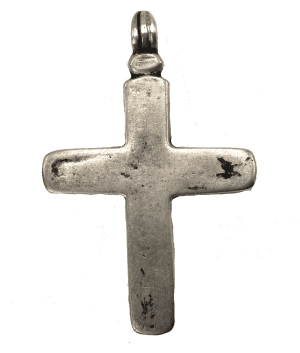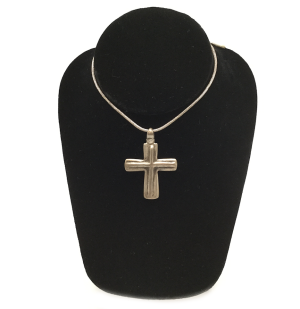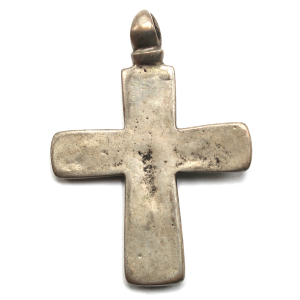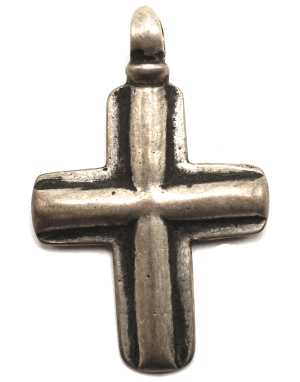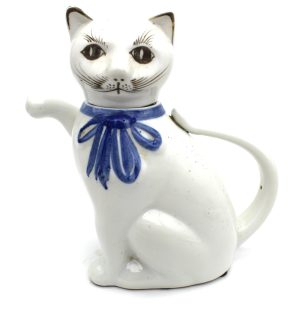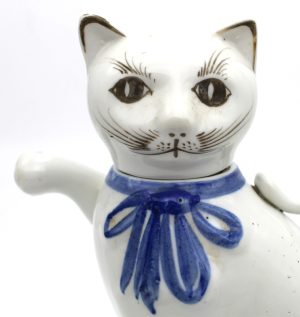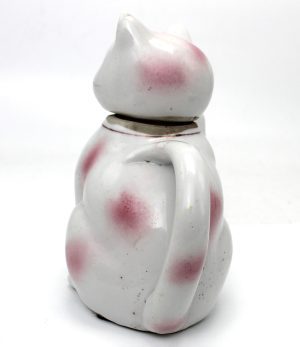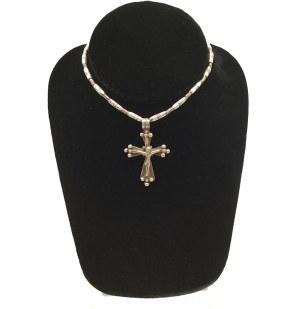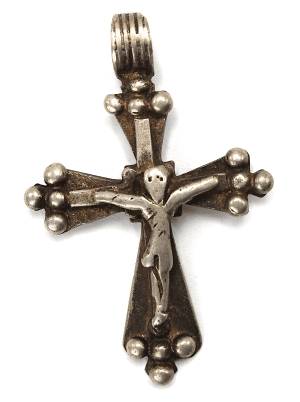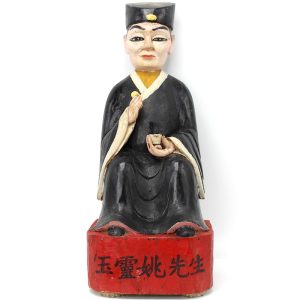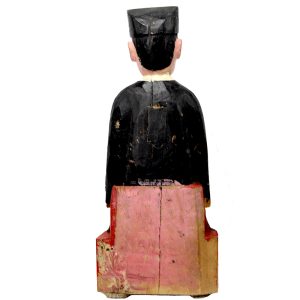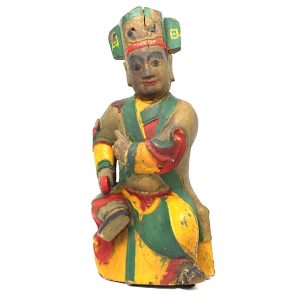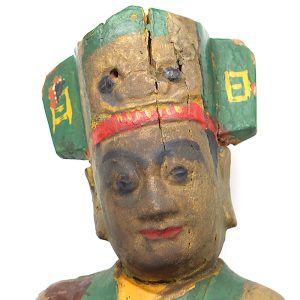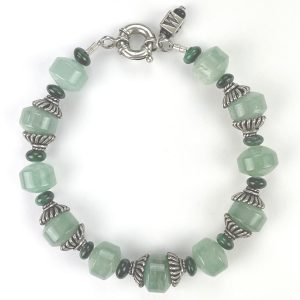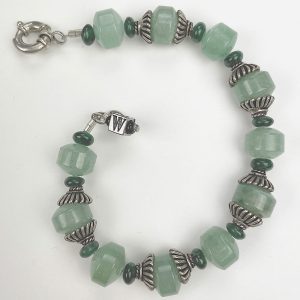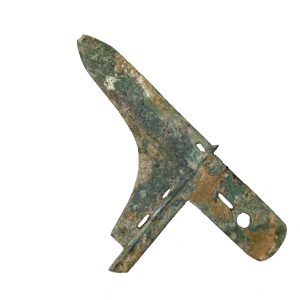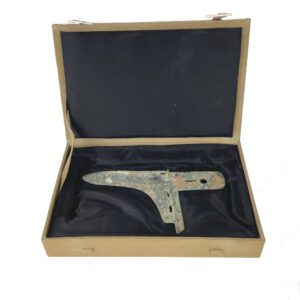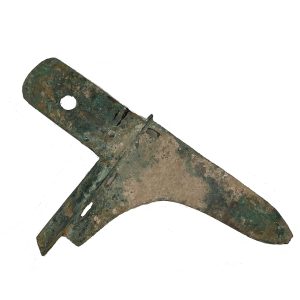Showing 121–132 of 203 results
-
Sale!


$195.00 Original price was: $195.00.$165.00Current price is: $165.00.
Ht: 2.75″ W: 1.81″ | FREE SHIPPING WITHIN CONTINENTAL U.S.
Elegant, large and heavy Latin Cross pendant with a raised rounded cross in the center and soft patina.
-
Sale!


$175.00 Original price was: $175.00.$150.00Current price is: $150.00.
Ht: 2.125″ W: 1.5″ | FREE SHIPPING WITHIN CONTINENTAL U.S.
Elegant Ethiopian Latin Cross with a raised rounded cross in center. Soft edges and matted surface from wear impart feeling of grace and warmth. Made using lost-wax, it is one-of-a-kind. Chain not included.
-
Sale!


$175.00 Original price was: $175.00.$150.00Current price is: $150.00.
Ht: 2.375 W: 1.5″ | FREE SHIPPING WITHIN CONTINENTAL U.S.
Simple Latin cross surmounted by a raised rounded cross in the center. Although it is heavy with a distinct and massive feel, its soft edges and matted surface impart a feeling of grace and warmth. Unadorned Latin crosses are relatively rare.
-
Sale!


$625.00 Original price was: $625.00.$425.00Current price is: $425.00.
H: 8.25″ W: 3.125″ D: 2.25″ | FREE SHIPPING!
This Kitchen God and his Wife is posed as streamlined virtual mirror-images and fashioned with a general quality relying on paint rather than deep carving for details. They sit on backless chairs on a plinth, with simplified gold officials’ robes with long color sashes, and well-carved black and gilt head gear. The wife’s face is smooth, generalized and the male face has a more deeply carved surface and painted highlights.
-
Sale!


$145.00 Original price was: $145.00.$125.00Current price is: $125.00.
H: 7” W: 7” D: 3.5” | FREE SHIPPING IN CONTINENTAL US
Porcelain cat teapot removable head, sinuous tail handle. Beautifully hand-painted whimsical ribbon-like blue collar, dangling ornamental bow, and the black accents. Likely Qing Dynasty circa 1900-1920.
-
Sale!


$135.00 Original price was: $135.00.$115.00Current price is: $115.00.
H: 5.5″ W: 3″ D: 3.375″ | FREE SHIPPING WITHIN CONTINENTAL U.S.
Antique porcelain teapot, removable head, tail handle, and spout paw. Hand painted design with ribbon-like gold collar and dangling ornamental bow symbolizing long life. Great gift, recommended for decorative use only.
-
Sale!


$385.00 Original price was: $385.00.$325.00Current price is: $325.00.
Ht: 1.875″ W: 1.687″ | FREE SHIPPING WITHIN CONTINENTAL U.S.
Antique Ethiopian Cross is unique as crucifixes with an image of Christ are rare in the Coptic tradition. Made by lost wax, the Christ figure and decorative arm ornaments were added, making a wonderful one-of-a-kind pendant with a warm patina.
-
Sale!


$215.00 Original price was: $215.00.$155.00Current price is: $155.00.
Ht: 14.75” W: 7.75” D: 4” | FREE SHIPPING WITHIN CONTINENTAL U.S.
Taoist priest in formal attire holding a cup with the elixir of health and longevity and small ingot symbolizing wish for prosperity and wealth. Characters on base are his name and the mythical “turtle spirit” that symbolizes longevity,
-
Sale!


$395.00 Original price was: $395.00.$295.00Current price is: $295.00.
H: 13.6 ” W: 7″ D: 5.5″ | FREE SHIPPING WITHIN CONTINENTAL U.S.
Taoist priest or shaman with a double-winged hat with a mythical taotie as a warning against greed and excess. His left hand in the Sword Gesture to cast out evil and right holding a tael symbolizing wealth and good fortune
-
Sale!


$155.00 Original price was: $155.00.$120.00Current price is: $120.00.
Length: 8.25″ | FREE SHIPPING IN CONTINENTAL U.S.
This contemporary finely crafted bracelet has a vintage feel with hand carved natural jade and malachite spacers set with spiral sterling fittings. Elegant, yet simple, it is a beautiful compliment to both casual and business attire.
-
Sale!


$495.00 Original price was: $495.00.$395.00Current price is: $395.00.
H: 4.375″ W: 7.375″ D:.1875″ | FREE SHIPPING WITHIN CONTINENTAL U.S.!
This ancient bronze ge dagger-axe is a true glimpse of the changes in military history and would be a great addition to a collection of weapons throughout the ages. Widely produced and used in the Han it virtually disappeared after introduction of chariots and tightly military formations.
-
Sale!


$395.00 Original price was: $395.00.$325.00Current price is: $325.00.
H: 4.375 ” W: 7.5 ” D: .24 ” | FREE SHIPPING WITHIN CONTINENTAL U.S.
Han dynasty dagger-axes (ge) like this were ancient military weapons.The dagger-shaped blade was mounted to a pole or shaft and secured using a shank and the holes on the two sections of its body. Their use ended with the advent of chariots and tightly packed military formations. He piece comes with a uniquely fashioned box.
End of content
End of content

